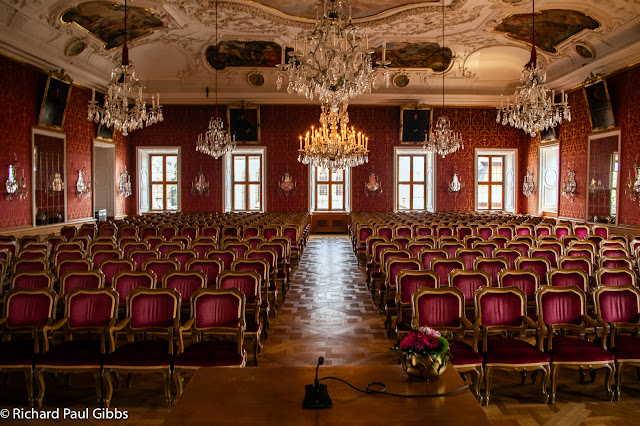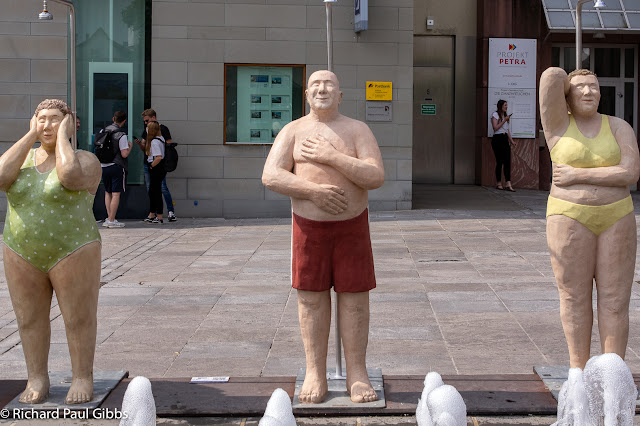Fulda....

The people of Fulda turn out to greet me.
Fulda (you Couldafooledme) is a town with something of the significance of Bielefeld (of which more in a later episode) and with some 70,000 inhabitants, a number of whom appear to have a fixed sort of smile under lidded eyes.....
A look of benevolent confidence?
There is a possibility that this relates to the relationship between the Gothic, as beautifully represented in St Michael's Church:
And the Baroque, which hides the remains of St Boniface, a native of Crediton in Devon who met his maker near Dokkum in Frisia on the 5th June 754 at the age of about 79. It may not be well known in the modern disunited kingdom, but Boniface (he from Crediton) became the patron saint of Germania and was known as the Apostle to the Germans..... Among other saintly attributes, Boniface (which could mean 'goodlooking' - though perhaps 'doer of good' is more acceptable?) was regarded as a unifier of Europe.... An accolade that appears to have fallen into disuse in these benighted times.....
Anyway, he has a message for us all today. Even if the neon has fizzled out a bit..... As Dame Edna Everage used to say, I only have Restaurant German, but I think this means You can bin things here.....
However, the good people of Fulda are dancing in the street,
Their gentle faces and well-groomed appearances (and tasteful jumpers).....
More important than the raindrops on their noses....
It is a gentle, well-meaning town. A bit Lichfield, perhaps, or maybe a bit Preston? I mean, if you were to visit England, and you had already seen London, and Oxford and Cambridge, and perhaps Windsor..... Where would you venture to sample the Real England? Uxbridge? (I think not, Ed)
Fulda: Difficult to categorise, but easy to navigate.
There is an enormous Stadtschloss in the epicentre, where a €3.50 ticket grants you access to almost every door on every floor of the Kafkaesque construction. It was built as the prince-bishops' residence by Johann Dientzenhofer (you will, of course, be familiar with his work?) between 1706 and 1717 but now doubles as a museum and tourist attraction with being a working Rathaus, so you can sample the mythological themes of ceilings by Tyrolean artist Melchior Steidl in one chamber, and then settle your outstanding recycling bin fees in an adjacent office....
I jest not, but it was extremely difficult to differentiate between the past and the present here. One room was cool plaster, another hot plush. I was driven to address the multitude of empty chairs, using every ounce of my rhetoric to exhort the populace to change their ways (though from what to what I was not sure.....)
But the populace, unmoved by the extreme wealth of the porcelain display within the Historische Räume, or the painted ceiling of the Fürstensaal, or the delightful Spiegelkabinett, seem to prefer to shower on the Universität platz:
Unabashed by the presence of a shady character, worryingly reminiscent of a representative of the Stazi (more of that later....) under the trees....
But there are other shadows, like that of the vines stretched above the yard outside Zum Stadtwächter, a welcoming bar, favoured by students and aged wanderers like me.
I strike up a conversation with a man who claims to have ridden here on a Vespa from the North Sea.
It take all sorts.....
And then, to sample the local cuisine and beer, to dinner at the Wirsthaus Schwarzer Hahn (the Black Cock) - where our host turns out to be from Thessaloniki.....
Nothing is quite what it seems.....
Not even breakfast in the Orangery in the morning.....
With many thanks to Christel and Laura Lechner -
the artists behind the Alltagsmenschen















No comments:
Post a Comment